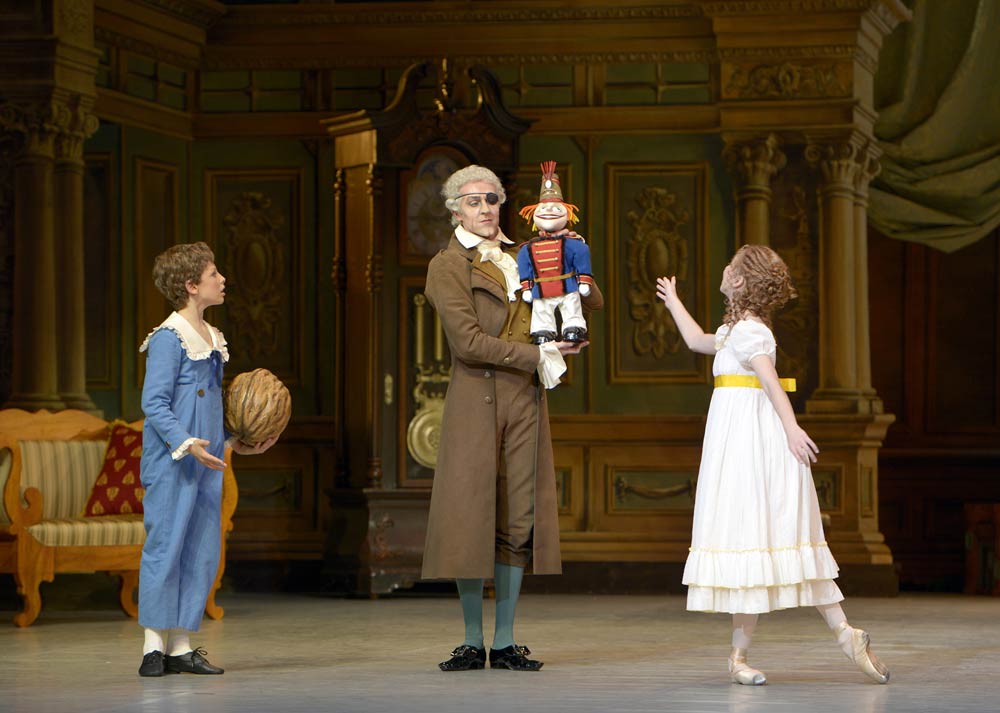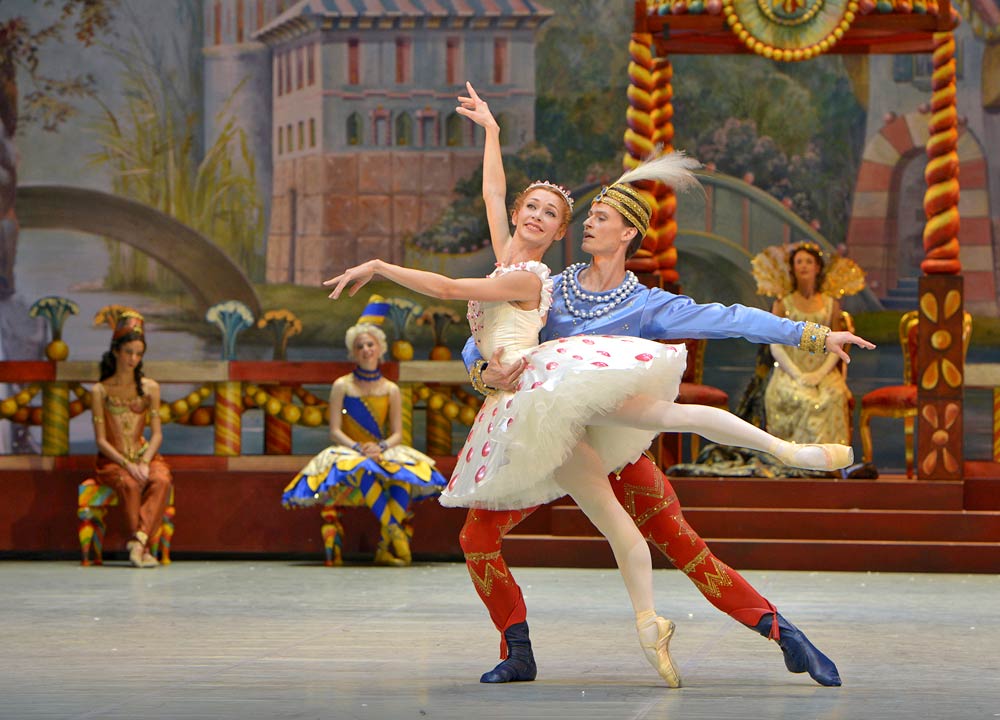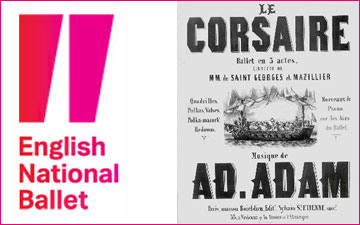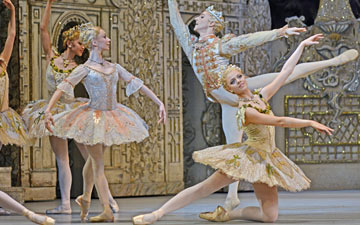
© Margaret Willis. (Click image for larger version)
Staatsballett Berlin
The Nutcracker
Berlin, Deutsche Oper
23 October 2013
www.staatsballett-berlin.de
www.deutscheoperberlin.de
Berlin never looked more beautiful. In the bright sunshine of an Indian summer its streets were paved with gold as leaves tumbled down like gentle snow from the linden and maple trees. However, on stage at the Deutsche Oper, winter had already arrived. Falling snow, sleighs and a Christmas tree announced the Staatsballett Berlin’s spanking new production of The Nutcracker, based on the original nineteenth-century ballet by Lev Ivanov. And what a spectacular production, both visually and choreographically, it proved to be. It is a gem which hopefully will stay in the repertoire for many years to come.
In his last season as Staatsballett’s artistic director, Vladimir Malakhov invited two celebrated Russian choreographers, Yuri Burlaka and Vasily Medvedev, to produce a truly traditional production without gimmicks of this beloved Russian classical ballet. Both men are serious dance historians and hold impressive résumés of their creative work. Together they reproduced the colourful and detailed ballet, Esmeralda, for the Bolshoi Ballet in 2011, also staged for Staatsballett. Burlaka, who was director of the Bolshoi Ballet from 2009 to 2011, also worked with Alexei Ratmansky in producing the very beautiful Le Corsaire and Paquita Grand Pas for the Bolshoi Ballet. For this Berlin Nutcracker, Burlaka and Medvedev have delved into the archives, not only for choreography but also for the original sets and costumes, and have added their own tasteful traditional-style choreography, including many children’s dances.

© Bettina Stoess. (Click image for larger version)
At the end of the 19th century, a sudden illness curtailed the plans of the great Marius Petipa to create a ballet from the tale by Hoffmann (after Alexandre Dumas) for the Imperial Russian Ballet in St Petersburg, and he handed the scenario about the awakening of a little girl first seen playing with dolls to the dawn of love of a brave and handsome hero, over to his assistant Ivanov. The Nutcracker’s premiere was on December17th 1892, but even with its resplendent sets and costumes, it was not an overnight success. However it did show the choreographer’s great talent and musical genius. While the first act is mainly mime and character dancing, it finishes with one of the masterpieces of classical ballet – the Snowflake scene. Here, the dancers weave gracefully around the stage in symphonic patterns, creating the feeling of snow falling softly in flurries, then giving the illusion of a blizzard as the pace accelerates and they scurry together. And today, with the twenty-four dancers in the costumes that one has seen in one’s own ballet books, the effect was magical. Using Ivan Vsevolozhsky’s sketches, Tatiana Noginova from the Mariinsky Theatre has recreated the delicate kokoshnik headdresses, which, like the tutus, are decorated with tiny pompoms. While the bodices are stiff and shiny, the assorted soft layers under the silk cover give the effect of powder snow.

© Bettina Stoess. (Click image for larger version)
Tchaikovsky’s evocative score was played with a sense of occasion by the Deutsche Oper Berlin orchestra, conducted by Robert Reimer and after the overture, the curtains rose on a snowy street scene where urchins staged a snowball fight as elegant guest arrived at the Silberhaus’ home. The first act takes place in a palatial drawing room with vaulted ceilings, panelled alcoves and pastel detailed paintwork. The traditional Christmas tree stands in a central huge arch, draped with elegant heavy curtains. The choreographers commissioned Andrei Voytenko to recreate the stage designs of Konstantin Ivanov and Mikhail Botscharov, and the results are impressive. (Obviously the family is exceedingly wealthy – in fact the cast sheet lists the host as President Silberhaus, which would explain it.)
The first scene is lively – the party is never dull – and the children’s dances attractive and well performed. The story unravels in a comprehensive way with no superfluous characters. Drosselmeyer’s three puppets, which arrive in three large wardrobes, are a young prince, a pretty princess and a Mouse King who attacks the boy, thrusting him back into the cupboard, which after a quick turn, reveals only a small wooden Nutcracker inside. The dolls that the young girls received as presents from the Silberhaus parents turn up in the battle scene, toddling in and out on pointe with stiff arms, as do various objects from the party scene. It becomes a fun fight with tiny mice throwing large chunks of cheese, gateaux and apples at the enemy, a cannon that wakes the audience up with its ear-splitting bang, solders on stick horses and the inevitable switch of the little and big Claras and Nutcrackers, which takes place behind Drosselmeyer’s cape. In this role, Michael Banzhaf offered good characterization in his eye-patch, green socks and shiny shoes, and in twirling and whirling in his black cape lined in sky blue and gold patterning. The Mouse King, who descends into the battle from the now huge cupboard was not scary enough – his steps could have been more powerful and menacing but his size was impressive.

© Bettina Stoess. (Click image for larger version)
The second act, set in the Kingdom of Sweets, bursts forth with bright sunshine and bright colours and is full of dancing. It also reveals a new-old twist on the story that I have never seen before. Apparently the Nutcracker is really Prince Coqueluche and this is his Kingdom, so he is reunited with his mother the Queen, and his three sisters. In clear mime, he tells them how he was transformed into the Nutcracker doll, and only when Clara hit the Mouse King with her shoe, did the enchantment end. The grateful Queen creates Clara a princess of the realm, and Drosselmeyer becomes the master of ceremonies for the celebration, in which the character dancers are clad in the exotic and brightly-coloured 1892 reproduction costumes. In the Spanish dance, Sarah Mestrovic, with her four cavaliers, performed with good attack and well-positioned balances, while in the Oriental dance, (normally performed by a woman), the soloist was a male dancer, accompanied by four harem girls. Stripped to the waist, with baggy pantaloons, Federico Spallitta moved sensuously with exacting technique, his sinewy and strong body undulating and contorting to the sway of the music. (For some reason the dance didn’t seem as long as it usually does!). The two Chinese dolls, Nanami Terai and Vladislav Marinov, were perky as they bobbed about showing off their tricks, while the Dance of Jesters (normally the Russian Trepak) was bright and cheerful, striking in black and yellow striped unitards with orange hair and pointy ears, with the lead man, Alexander Shpak, dancing tautly, and jumping in and out of a hoop. The delicate stepping Mirlitons were in electric blue and yellow-edged tutus, striped tights and off-kilter snappy hats, while six tiny beaming girls in red satin slippers stole the show with their self-assurance and accuracy in the Mère Gignone and polichinelles dance. The Waltz of the Flowers saw dancers dressed like sunflowers in dull yellow and green, and frilly caps with stalks. Here we saw for the first time Petitpa’s idea for the dance. A huge porcelain vase was wheeled on by four flunkies who unrolled golden chains for the four lines of dancers to hold onto – though later they got to dance with the usual garland half hoops. The dance was fluid and attractive and the patterning nicely thought out.

© Bettina Stoess. (Click image for larger version)
The scenario comes full circle with the grand pas de deux. Clara, now Princess Sugar Plum wears the same sparkling white silken tutu dotted with pink dewdrops that the puppet had worn in Act 1, and Prince Coqueluche is dressed in the plumed headdress, boots, red trousers and blue tunic of the Nutcracker puppet,. Principals Iana Salenko and Marian Walter look like teenagers, their young faces expressing the wonder and excitement of the unfolding events. Salenko has a refined style showing strong long balances, creamy yet sharp technique, and her Sugar Plum solo was done with delicacy and graciousness. Walter is a high leaper, has good tight turns and shows careful partnering skills. One of the interesting highlights was seeing Salenko standing on a long silken cloth, pulled across the stage by Walter –which explains the unusual pose in the photo from the 1892 performance.

© Bettina Stoess. (Click image for larger version)
The whole company was on fine form and congratulations must go to the ballet staff at Staatsballett and to the Russian duo who, with assistant Stanislav Feco rehearsed and coached the company for this fine presentation. However, it was the children who stole the show. Each young dancer was a mini-professional displaying excellent training and confident stage presence. Feet were always pointed, arms elegantly held and their faces showed how much they were enjoying themselves, from the youngest, aged nine, to the older students. Twelve-year-old Sabrina Salva Gaglio made a convincing young Clara. She has a lyrical flow to her dancing and a good stage presence. Her brother Fritz, played by Nikolai Petrak, was a typical brother, annoying and teasing, and he acted the role well. With such good youthful exponents of classical ballet, the future of the Staatsballett Berlin looks to be in safe hands – and feet.

















You must be logged in to post a comment.